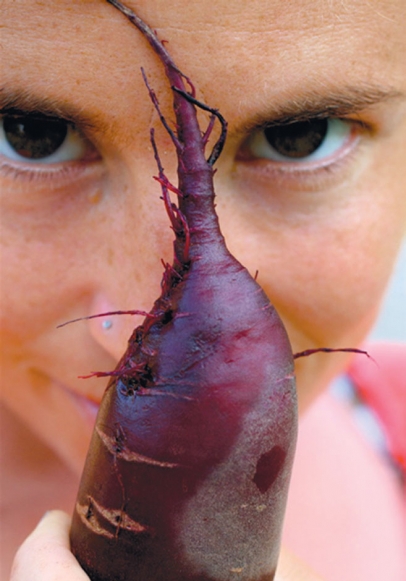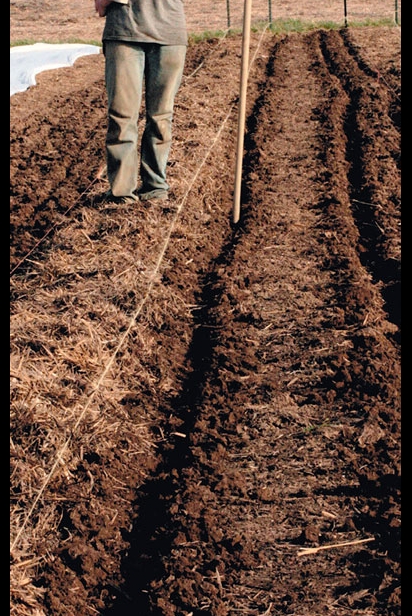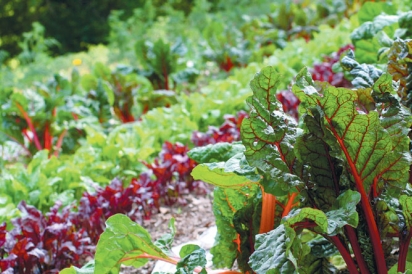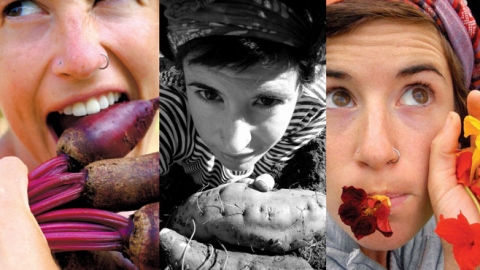Talk Dirty To Me: On Permaculture, Straw Bale Building, Soil Conditioning
Winter 2015
I’ve been practicing organic gardening for years. Lately, though, I see the word permaculture more and more. Can you explain the difference between these two terms and what I can do to make my gardening practice more permaculturish? Love reading your column!
Nic in the Northland
That’s a great question. “Permaculture” as a movement is becoming increasingly popular amongst organic gardeners and “green” enthusiasts alike. However, the term is used in a rather broad (even abstract) manner and when it comes right down to it, I’m not sure if many of us know exactly what it means!
Permaculture is an agricultural philosophy born in Australia in the 1970s. The word itself is a combination of two words: permanent and agriculture. One of the founding fathers, Bill Mollison, defines permaculture as “the conscious design and maintenance of agriculturally productive ecosystems, which have the diversity, stability and resilience of natural ecosystems”.
In simpler terms, permaculture aims to mimic nature’s self-sustaining systems in the garden thus producing more nutritious foods with less human intervention/labor and strain on environmental resources. Think organic gardening evolved…where the grower is not only consciously avoiding the use of chemicals and chemical-based fertilizers, but is also implementing systems and ecological designs that maintain themselves, protect themselves, feed themselves, and replenish nature all at the same time.
More than a specific way of growing food in the garden, permaculture in today’s understanding has become a general way of life that looks at all aspects of living, such as how we design our living spaces, how we obtain and use our energy, how we manage our waste, what we use for fuel, and how we share/combine our community resources. Ethics, advocacy, and global responsibility are priorities for the true permaculturalist. Every action or need is thoughtfully calculated as one strives to live in accordance with nature.
As for making your gardening practices more “permaculturish” as you put it, here are a few concepts to consider:
• Consider the entire landscape and not just the garden itself. The frontyard, backyard, sideyard, patio, balcony, driveway, and even rooftop can potentially fit into a wholly efficient and sustainable homestead to feed, fuel, and entertain a family.
• The homestead design should be broken up into zones for functionality and flow. For instance, a heavily used feature such as an herb garden should be placed in a more accessible zone, while a native (self-sustaining) “food forest” might be placed towards the back of the property, furthest from the house.
• Design your site based on the specifics of your microclimate and take advantage of the land’s diversity (and even it’s flaws!). No doubt your yard has cool shady areas, soggy low patches, wind-swept sunny spots…all of which present unique opportunities. For example, elderberries, asparagus, or blueberries can be planted in wetter soils, while drought tolerant natives can be planted in dry areas with low fertility.
• Utilize the beneficial layering of various plant species, known as a guild. A guild stacks plants with compatible roots and canopies to form a symbiotic relationship that is both aesthetically pleasing and productive. Midwest Permaculture (midwestpermaculture.com) provides nine lovely guild lay-outs in the following PDF: midwestpermaculture.com/eBook/ Plant%20Guilds%20eBooklet%20-%20 Midwest%20Permaculture.pdf
• Go for the greatest diversity in your landscaping, paying particular attention to native plants. These plants are well adapted to your climate and don’t tend to suffer from disease or pest pressure nor do they need much care or water. Native fruits like persimmons and pawpaws are a joy to consume, and native wildflowers attract a host of beneficial insects.
• Apply a “no-till” or “low-till” practice in your vegetable garden. Think of a forest floor: organic matter in the form of leaves falls from the trees fertilizing & replenishing the soil creating the ideal conditions for plant roots. In addition to leaves, animals interact with the forest floor - scratching, burrowing, pooping, and dying. (Their very own carcasses feeding the roots of the plants they consume.) Remove tractors and tillers from the equation. Use heavy straw or old hay mulch in the garden at all times to suppress weeds, retain moisture, and provide delicious organic matter. Run chickens or other livestock directly on top of your garden beds when fallow to fertilize and prep for the next planting.
Integrate animals into your homestead. In nature, animals & plants coexist and one needs the other to flourish. Use specific animals to heighten your permacultural systems and provide nutritious calories. Chickens can be used for eggs, meat, pest management, and fertility. Goats are great for milk, meat, fertility, and brush removal. Sheep mow lawns while making milk, meat, and wool. Bees produce honey while greatly enhancing the pollination of crops. Geese, ducks, guineas, pigs, etc., have special qualities and provide specific resources that can be utilized in holistic food-producing systems.
Hello! I am interested in building a straw bale structure in my backyard for my chickens. Do you think this would be a good idea? Can you recommend a good resource for guiding me through the process?
Thanks!
Amy
Eudora, KS
Straw bale structures are particularly enticing for their general aesthetic appearance, cheapness and accessibility of materials, “low-fi” construction, and insulative nature. That said, straw bale construction in the Midwest is not a common practice due to our climate’s high humidity and the possibility of moisture getting into the bales affecting the long-term integrity of the structure. Of course, many lovely straw bale structures do exist in our neck of the woods and only the test of time will tell.
As for using straw bale construction for a chicken house, it may not be worth your time and energy. Straw bale construction is extremely labor-intensive and, although the birds wouldn’t mind it, they don’t necessarily need the insulation provided by the straw bales even in extreme temperatures.
Straw bale construction is typically used in structures inhabited by humans to curb heating/cooling costs and enhance the home’s efficiency. When considering the energy and dollar savings that can come from a straw bale home, the labor is well worth it. For the birds on the other hand, it may be a bit excessive.
If your goal is to creatively build a low cost, “green” structure for your birds, you might consider using salvaged, repurposed materials instead, such as scrap lumber, pallets, reclaimed sheet metal, old bill boards, doors, re-purposed trailers for moveable housing, etc.
If your goal is to meticulously craft and mold a beautiful structure out of natural materials and learn from the process, then straw bale may be a good option. Just make sure you act at the appropriate time of year, when rainfall is less likely, and keep those bales bone-dry during the building process.
There is such a thing as a “raw bale” chicken coop design where stacked bales of straw are used for certain walls, left raw, and replaced over time. This type of construction would not be labor intensive and could incorporate scrap materials along with the straw bales. Here are links detailing such a coop: http://www.milkwood.net/2011/06/07/rawbale-chicken-house-design/ http://permaculturenews.org/2012/10/08/diy-straw-bale-chickencoop/
I live on a small lot mostly covered by old concrete. I want to rip it out and start from scratch so that I can put in a garden. I’m sort of scared that decades of this hard surface may have ruined my soil. Any idea on how I should go about turning my little patch of land into fertile ground?
Keith, KCMO
It’s possible to turn just about any patch of land into decent growing space, but depending on the situation it can take lots of time and money to do so. At our farm, we take the long and inexpensive approach to replenishing soil, lovingly adding organic matter and fertility year after year.
Ripping out the concrete is certainly an option if you need all of the space for growing. The ground can be amended immediately with good growing medium (soil and compost) or over time. Before you rip up the concrete, though, it would be smart to test the soil for contaminants like lead. You might cut out a small section first and test the soil below the gravel.
A better option may be to build raised beds, two to three feet high, ensuring plenty of space for plant roots to thrive. This will be an expensive option, but could prove to be cheaper and more successful than ripping out the concrete. If you scrap the lumber for the raised beds and build them yourself, you can keep costs down significantly. While scrapped lumber is the cheaper option, rot resistant cedar is a better material for long-term durability.
Raised beds will need to be filled with top soil and compost. Missouri Organic (www.missouriorganic.com) delivers high quality soil blends, compost, and mulch by the truckload. Since you live in KCMO, you might want to become a member of the Kansas City Community Gardens (www.kccg.org). Membership is very cheap and they might be able to lend some free consultation and help you get started. Best of luck!
Send your gardening, homesteading, cooking, and “green” lifestyle questions to askbrooke@ediblekansascity.com









